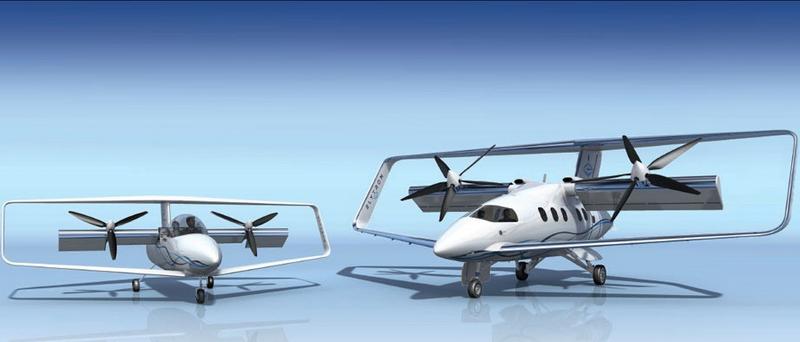Oliver Garrow has been pursuing the dream of vertical takeoff and landing (VTOL) flight for a decade, starting long before it became the currently fashionable ideal for “flying car” enthusiasts. He sold a little over 1,000 simulation packages to enthusiasts, who could “fly” variants of the Verticopter™ ranging from three to 65 feet in span. At the same time in 2010, Garrow was testing large radio-controlled models of the concept at NASA Ames, Moffett Field, California.
The craft’s configuration changed considerably as Oliver refined his concept, with a full-scale prototype displayed at the HAI (Helicopter Association International) Helicopter Expo in Orlando, Florida in 2015. The company and vehicle names changed to VTOL Aerospace and Converticopter™.
Later, Garrow’s team tested the static thrust of the prototype, achieving close to 1,000 pounds of thrust at about 1/3 throttle on the 450 shaft horsepower turbocharged engine.
Here it’s shown in hover in 96-inch span model (CVC96) form earlier this year. The use of electric motors may show a direction for future development of full-scale aircraft. Such a design would probably simplify the drive system in the tilt-wing configuration.
Recent tests at Hayward, California with the CVC96 show great controllability and intriguing tuft testing. The black yarn attached at regular intervals to the lower wing shows persistent attachment at all angles of attack, demonstrating excellent laminar flow throughout the model’s speed range.
Garrow reports on these latest flights. “It was verified and corroborated through systematic simulations and flight tests, that the production airframe would benefit from a L/D (lift-to-drag) ratio above 15.0 at loitering speeds, allowing very efficient and extended flight time.
“The company highlights the features of a compact Converticopter version (CVC96) with a wingspan of 8-ft, allowing loiter flights up to 1.5 hour, only on battery power alone, and beyond 5 hours with an electric hybrid power plant. Larger payload sizes and longer flight times may be achieved by scaling up the airframe, and its power source, up to 40 ft in wingspan. Additional CVC models with various wingspans may be offered by manufacturing partners, who are to subscribe to a manufacturing license agreement.”
These ongoing experiments, including work in NASA Ames’ wind tunnel and at full-scale and model sizes, shows hope for Garrow’s ambitions for the project, including”
“· Vertical take-off with considerable payload
“· Self-stabilizing and self-rectifying hover flight transition
“· Rapid and safe conversion to conventional flight
“· Adaptive flight patterns based on the selected mission, including low-speed loitering.
“· Extended flight time due to a low-drag, high-lift airframe
“· Ability to land vertically any time in the midst and/or at the end of the mission.”
The appreciable glide ratio itself is a feature that many multicopters don’t enjoy, and the thought of failures dropping half-ton or bigger vehicles on the landscape below, even with parachutes,” is not comforting. Converticopters at least have a controllable glide path that may avert such disasters.

